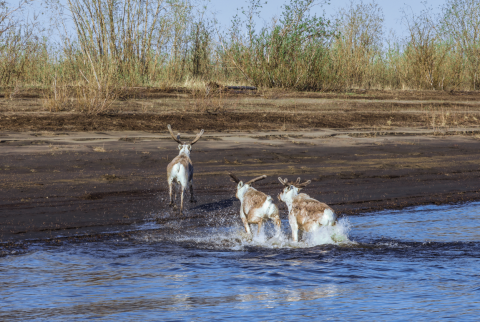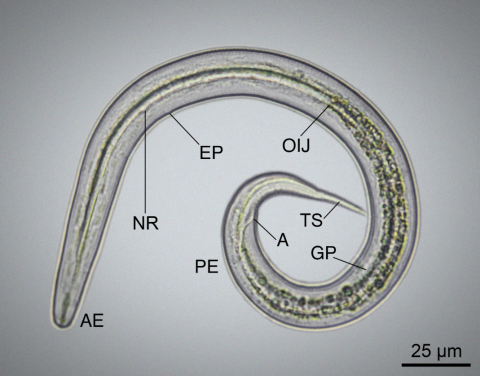
Researchers of the IEE RAS Parasitology Center together with specialists from the “United Directorate of Taimyr reserves” conducted a study on the feces of wild reindeer deer (Rangifer Tarandus) to find out which helminths parasitize them. The material was assembled on the banks of the Heta River (71 ° 10 ’78” n; 98 ° 04’15 ”E), which the northern deer crossed during annual migration.
In addition to the parasitic nematodes of the gastrointestinal tract of the Strongylida detachment (detected in the stage of eggs and living larvae), characteristic of all ruminants, and Paramphistum trematodes (eggs) typical of the northern deer, nematodes of the Protostrongylidae family, belonging to two morphological forms. The structure of these larvae corresponded to the appearance of Elaphostrongylus rangiferi (the only protostostrongilid typical for the Northern deer in Eurasia) and nematodes of the genus Protostrongylus (characteristic of Eurasia, but not for the northern deer). However, the analysis of the nucleotide sequences of two sections of ribosomal repetitions (ITS2 and LSU RDNA) showed that these larvae most likely relate to the types of Varestrongulus Elegunenensis and Orthostrongylus macrotis (Orthostrongylus was originally described as a Protostrongylus), respectively. (Both nematodes are parasitized in the respiratory system).

The detection of the larvae of the genus Orthostrongylus in the northern deer is very unexpected. The genetic distance in the ITS2 and the absence of adults of nematodes at our disposal forces us to suggest that this may be a case: (1) conspecifics; (2) different species that may or may not belong to the same sister group.
Protostrongilids found in the Taimyr Northern Deer can indeed be O. Macrotis, a non-Arctic parasite, which was previously observed only in North American deer and antilocapra. This assumption is confirmed by several facts. In particular, the detection of V. Elegunenensis larvae. In Finland, V. Alces and V. Capreoli are sometimes found in the northern deer, but they differ from V. Eleguneniensis (as the species was first described only 8 years ago); perhaps the last species in Eurasia has been noted by us for the first time.
The northern deer is considered to be the secondary final host for V. Elegunenensis, and the Ovibos moschatus as the primary host. It is known that in the 1970s 30 sheep were brought to Taimyr: ten from the island of Banks (West Canada) and twenty from the island of Nunivak (West USA), and by 2011 their population had already grown to 7200 individuals. It is likely that V. Elegunenensis (and O. Macrotis) were introduced on Taimyr along with muskoxen from Alaska and Canada. It is known that the muskoxen are carriers of V. Elegunenensis and the representers of the Protostrongylinae family (although it is assumed that this is Protostrongylus stilesi or P. rushi due to sympathy with the rams of Dalla). In those northern latitudes where we took the feces, the muskoxen do not graze next to the deer, but in the more southern part of Taimyr in the winter, these ruminants intersect. Just as the change of hosts from the rams of Dalla to muskoxen occurred against P. Stilesi in Canada, the change of hosts from muskoxen to the northern deer could occur in relation to O. Macrotis in Taimyr.
Therefore, the re-introduction of the sheep could be the source of both O. Macrotis and V. Elegunenensis. Such a phenomenon of Nematod introduction, together with the carriers from North America, repeats the history of Rumenfilaria Andersoni introduction in Eurasia with Fennoscandian deer. As an alternative, it is also possible that V. Elegunenensis is endemic for Russian northern deer.
The studied northern deer are also sympatric with moose (Alce alces) and snow sheep (Ovis nivicola). Since the North American elk can be infected by O. Macrotis, Taimyr moose may be infected with some kind of related protostrongilid and, therefore, “share” it with the northern deer. In addition, in 1964, unidentified Protostrongylus was registered in Yakutia in snow sheep.
From the Parasitology Center, IEE RAS, a candidate of veterinary sciences Olga Alexandrovna Loginova and a doctor of biological sciences Sergey Eduardovich Spiridonov participated in the study. From the "United Directorate of Taimyr reserves" - Doctor of Biological Sciences Leonid Alexandrovich Kolpashchikov. The article was published in Parasitology Research (Q1 in Scopus) (https://doi.org/10.1007/s00436-022-07754-7) and is available here: https://rdcu.be/c1d0e.
Loginova, O.A., Kolpashchikov, L.A. & Spiridonov, S.E. FIRST Report of Orthostrongylus SP. (NEMATODA: Protostrongylidae) In Wild Reinder (Rangifer Tarandus) from the Taimyr, Russia: Nearctic Parasites in a Palearctic Host. Parasitol res (2022).
